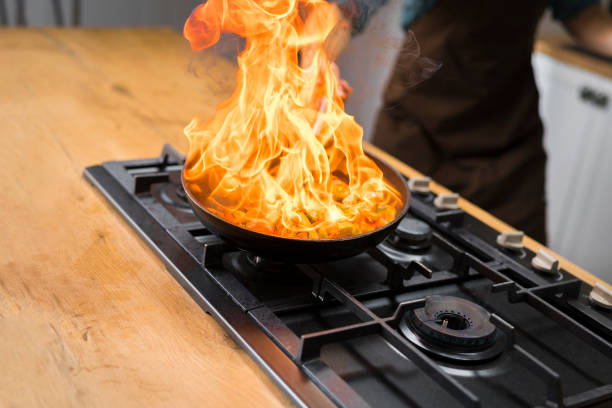Extinguish the fat fire properly. If the hot oil or fat gets onto the stovetop or the ceramic hob while cooking, it can ignite. Or it suddenly starts to burn in the pot. Then you should keep calm and follow these tips to extinguish the burning fat.
Oil and fat fires can quickly break out in kitchens. And these are not harmless. That’s why you shouldn’t act rashly. You take your eyes off the hot stove for a moment and it’s happened. But how do I put out the fat fire properly? Consequently, we will tell you what you should pay attention to in such a situation.
How does an oil and fat fire develop?

Such a fat fire occurs when the oil or fat is heated too much. Because at over 280 degrees, the fat can catch fire and, in the worst case, spread. Since most stovetops can get above this number of degrees, fires often break out in the kitchen. This should be avoided by turning the stovetop temperature down a little after the pan has heated up initially.
Why you shouldn’t extinguish burning oil with water
You should never put out burning oil with water. Because if you pour water on the burning oil, there will be a deflagration. This causes the flames to leap higher and the hot oil squirts through the kitchen like a mini-explosion. Consequently, this can lead to severe burns on the skin.
How to extinguish burning fat?
How do I behave correctly if there is burning fat in the kitchen? There are several ways to get the fire and flames under control. Of course, it is important to weigh up how dangerous the situation is. If the fire is already too big, don’t hesitate to call the fire brigade. Such a fire can be very dangerous. But if it’s a small flame, you can put it out yourself.
1) Extinguish with a lid and a damp kitchen towel
If your stovetop is on fire, turn off the stove and douse the flames by throwing a damp kitchen towel over the flames. This deprives the fire of oxygen and suffocates it. If the only fire is in the pot or pan, put a lid on it. So the fire goes out quickly. Read the following article on how to remove burnt-in marks from the stovetop.
2) Fire blanket only suitable to a limited extent
A fire blanket made of flame retardant material can extinguish a fire. But if used incorrectly, there is also a risk of burns and unextinguished fat fires. If you don’t have a fire blanket at hand at home, you should definitely not use other blankets. Because these can burst into flames in high heat and additionally accelerate the fire. Also, read how to effectively remove the burnt smell.
3) Fight grease fire with extinguishing spray

So-called extinguishing sprays are a good means of extinguishing small fires. Although they don’t stand a chance with larger flames, these are easy to use and can be found in every kitchen. In addition, they are inexpensive. If your pan, the Advent wreath, or the hob starts to burn, you can use it quickly and easily.
4) Call the fire brigade in the event of a grease fire
Since a grease fire can be very dangerous, you should not hesitate to call the fire brigade. Especially if the fire has already grown large and threatens to spread. Because the most important thing is to get yourself and others to safety so that nobody gets hurt. You can see how dangerous such a fire can be in the following video. Also, note our tips on liability insurance for the family.


